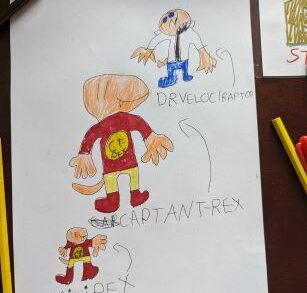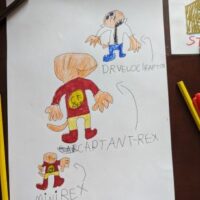Inspiration
The inspiration behind writing this article about guiding your child with writing their very own creative story is my own family. It was world book day this week, and my youngest son’s class had a very special day. They had the visit of a real-life children’s book author of “Why am I here?”, Lindsay Daniels. It was all very exciting, and it inspired my youngest son E, who is 8, to write his own creative story. At home, we set ourselves on a quest to write the best story! Don’t get me wrong I was merely his assistant. E is the real author. It also inspired my eldest K, 9, who is now in the process of writing his own. We will publish their stories on this blog once it’s ready if they want to. I am no stranger to writing creative stories, but my son is his own awesome wee man, and I needed to find out how to keep him captivated and gently guide him with writing his very own creative story, rather than direct him.
As you may already know, neurodiversity has its perks, one of which is hyperfocus. And above anything, I love doing research! So, I set myself out on a quest on how to have the best time writing a creative story with my wee buddy.
Guide your child to writing their very own creative story
Brainstorming Ideas to Get Your Child’s Imagination Flowing
When it comes to creating a story with your child, brainstorming is key! Have your child think of a few different topics and let their creativity take the lead. You can provide guidance, but allow them to explore possibilities and get really creative! Here are some ideas to get started:
- Invent a character – For example, you can have your child think up an animal that doesn’t exist in the real world. What does it look like? How does it move? What kind of environment does it live in?
- Write from a Different Perspective – Inspire your child to write from the point of view of a character who’s different from themselves. They can become a superhero or a scientist, or even an animal or object!
- Create Fantasy Worlds – Help your child create an entire world within their story. This can be anything from an undersea kingdom to a rainforest paradise. Have them explore what makes this world unique and incorporate details like its inhabitants, geography, plants and more.
By providing plenty of ideas to spark their imagination, you’ll help ensure your child’s story is truly one-of-a-kind.
The three golden rules:
- Let your child brainstorm ideas first, before you provide any guidance or feedback—this will help them think outside the box, challenge themselves and be creative with their ideas without worrying about making mistakes.
- Encourage your child not to rush their process—creative stories take time and effort, so let your child explore different possibilities before beginning writing.
- Listen carefully as your child talks through their ideas or reads drafts of the story out loud—this will give them a better sense of how it flows and which words stand out or have impact.
Keeping the Story Moving Through Plot Development
One of the most important things to keep in mind when writing a creative story with your child is plot development. It’s important to make sure the story has a clear beginning, middle, and end. Your child should be able to explain what happens in each part of the story.
Your child will likely come up with many ideas as you go along. Help develop those ideas further and ask lots of questions about the plot line and characters in order for your child to think deeper about their story and create something truly unique. Here are some tips to help you guide them in this process:
- Encourage your child to think through their plot line thoroughly and come up with interesting characters along the way.
- Have them identify subplots that can be woven throughout the main plot, adding complexity.
- Have them use key dialogue between characters as part of moving the plot forward.
- Help refine any necessary details that are needed for a proper, complete storyline.
- Discuss inconsistencies or “holes” in the story and have them come up with solutions by using their own creativity.
By taking these steps during their writing process, your child will gain confidence in their own storytelling abilities while having fun doing it!
Tips & Strategies for Editing and Publishing Their Story
Once your child’s creative story is written, it’s time to put the finishing touches on it! Editing and publishing the story is an important step that can help your child understand how to hone their craft as a writer and storyteller. Here are some editing and publishing tips and strategies that you can use with your child to get the most out of their experience.
Read Aloud and Revise
I found with experience that the best way to edit a story is to read it out loud. Have your child read through the entire piece aloud a few times. Do focus on any areas that may need further explanation or more attention. Encourage them to make revisions as they read through it—this will help them hone their writing skills even more!
Publish The Story & Celebrate Accomplishment!
Once you’ve gone through the editing process with your child and feel like the story is ready for its big debut, it’s time for publication! Encourage your child to share their work with family and friends. It could be through email or printing copies for everyone in the household, then celebrate all of their hard work together!
To conclude this article, at the end of the day, there is no wrong or right way to write a creative story, and that is the beauty of it. Your child might already have a great idea in their head and all you have to do is help them express it. Remember to focus on the process rather than the end result and encourage your child to use the tools which they have at their disposal. Writing can be a great way for your child to unleash their creativity; it certainly was for me growing up. With your help and encouragement, your child can write a truly captivating story for all to enjoy.









